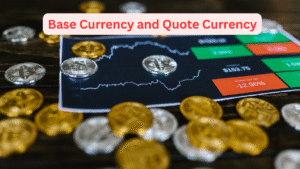 💱 Base Currency and Quote Currency in Forex Trading: What You Must Know
💱 Base Currency and Quote Currency in Forex Trading: What You Must Know
In the dynamic world of forex trading, understanding currency pairs is foundational. Every currency pair represents a tug-of-war between two national currencies. At the heart of this is the concept of base currency and quote currency—terms that might sound complex at first but are crucial for accurate trading decisions. In this post, we’ll break down these terms, show you how they work with real examples, and include a visual chart for clarity.
🔍 What Is a Currency Pair?
A currency pair in forex represents the value of one currency relative to another. It’s displayed as two abbreviations separated by a slash, such as EUR/USD, where:
- The first currency (EUR) is the base currency.
- The second currency (USD) is the quote currency.
This quote tells you how much of the quote currency is needed to buy one unit of the base currency.
🧭 Base Currency Explained
The base currency is the currency you’re buying or selling in a forex trade. It’s the reference point and always equals one unit.
💡 Key Points:
- Appears first in a currency pair.
- Considered the “primary” currency.
- Price movement reflects its value against the quote currency.
✅ Example:
In GBP/USD = 1.30, the base currency is GBP (British Pound). This means:
- One pound equals 1.30 US dollars.
- You need $1.30 to buy £1.
💵 Quote Currency Demystified
The quote currency is what you exchange for the base currency. It tells you the cost of one unit of the base currency.
💡 Key Points:
- Appears second in the pair.
- Also called the counter currency.
- Reflects the amount needed to purchase 1 unit of the base currency.
✅ Example:
In USD/JPY = 160.50, the quote currency is JPY (Japanese Yen). This means:
- $1 USD buys 160.50 yen.
- If the rate rises to 162.00, the dollar has strengthened against the yen.
📈 Visual Guide to Currency Pairs
Here’s a simple chart you can include in your blog for better user understanding:
| Currency Pair | Base Currency | Quote Currency | Meaning |
|---|---|---|---|
| EUR/USD | EUR | USD | €1 = $1.10 |
| GBP/JPY | GBP | JPY | £1 = ¥180.50 |
| USD/CAD | USD | CAD | $1 = C$1.35 |
| AUD/NZD | AUD | NZD | A$1 = NZ$1.08 |
🔁 Why Understanding Base and Quote Currencies Matters
Trading success depends on knowing what you’re actually buying or selling. Here’s how:
Scenario 1: Long Position (Buy)
You go long on EUR/USD at 1.10.
- You’re buying EUR (base).
- You’re selling USD (quote).
- If the price rises to 1.15, the euro gained value.
Scenario 2: Short Position (Sell)
You short GBP/JPY at 180.50.
- You’re selling GBP.
- You’re buying JPY.
- If the price drops to 178.00, the pound weakened, and you profit.
❓Base Currency and Quote Currency: FAQs
What is the base currency in forex trading?
It’s the first currency listed in a pair and represents the currency you’re buying or selling.
How do I interpret EUR/USD?
EUR is the base, USD is the quote. A rate of 1.10 means one euro equals 1.10 U.S. dollars.
Can the base and quote currency switch?
Yes, depending on how the pair is listed. For instance, USD/JPY vs. JPY/USD reflect two different relationships.
🧠 Base Currency and Quote Currency: Final Thoughts
Mastering the concept of base and quote currencies will equip you to read forex quotes accurately and make more informed decisions. Whether you’re building your first trading strategy or optimizing your existing one, this knowledge is non-negotiable.
